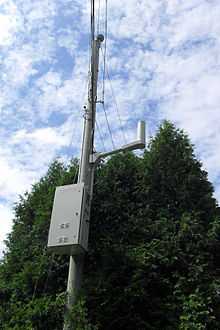Distributed antenna system



A distributed antenna system, or DAS, is a network of spatially separated antenna nodes connected to a common source via a transport medium that provides wireless service within a geographic area or structure. DAS antenna elevations are generally at or below the clutter level and node installations are compact.
Concept
As illustrated in the figure, the idea is to split the transmitted power among several antenna elements, separated in space so as to provide coverage over the same area as a single antenna but with reduced total power and improved reliability. A single antenna radiating at high power (a) is replaced by a group of low-power antennas to cover the same area (b). The idea was described in a paper by Saleh et al.[1] in 1987. These antennas have recently been employed by several service providers in many areas around the United States. DAS is often used in scenarios where alternate technologies are infeasible due to terrain or zoning challenges.
The idea works because less power is wasted in overcoming penetration and shadowing losses, and because a line-of-sight channel is present more frequently, leading to reduced fade depths and reduced delay spread.
A distributed antenna system can be implemented using passive splitters and feeders, or active-repeater amplifiers can be included to overcome the feeder losses. In systems where equalization is applied, it may be desirable to introduce delays between the antenna elements. This artificially increases delay spread in areas of overlapped coverage, permitting quality improvements via time diversity.
If a given area is covered by many distributed antenna elements rather than a single antenna, then the total radiated power is reduced by approximately a factor N1–n/2 and the power per antenna is reduced by a factor Nn/2 where a simple power-law path-loss model with path-loss exponent n is assumed. As an alternative, the total area covered could be extended for a given limit of effective radiated power, which may be important to ensure compliance with safety limits on radiation into the human body.
Use in WiFi networks
Using a distributed antenna system to create an area of wireless coverage, it is possible to use this technique to propagate indoor WiFi for commercial uses. It is estimated that only about 5% of commercial WiFi use a distributed antenna system.[2]
Regulatory challenges
There are several regulatory challenges that arise out of DAS deployments. Regulatory challenges arise at the federal, state and municipal levels. Recent academic works address this.[3] [4] Other industry resources like The DAS Forum also address regulatory issues in their conferences. More details can be found on their website.[5]
See also
References
- ↑ A. A. M. Saleh, A. J. Rustako and R. S. Roman, Distributed Antennas for Indoor Radio Communications, IEEE Transactions on Commun., vol. 35, pp. 1245-1251, Dec. 1987
- ↑ "Estimate made by LComm Global". Lcommglobal.com. Retrieved 2012-10-24.
- ↑ "Establishing a Regulatory Framework for Distributed Antenna Systems". Ssrn.com. Retrieved -2012-10-24.
- ↑ "Distributed Antenna Systems - Establishing a Regulatory Framework Available". Amazon.com. Retrieved 2012-10-24.
- ↑ "The Distributed Antenna Systems Online Community". The DAS Forum. 2012-08-17. Retrieved 2012-08-22.